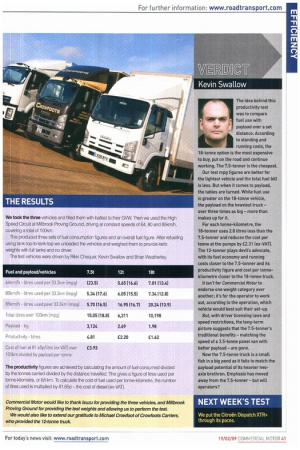The idea behind this productivity test was to compare fuel
Page 41

If you've noticed an error in this article please click here to report it so we can fix it.
use with payload over a set distance. According to standing and running costs, the 18-tonne option is the most expensive to buy, put on the road and continue working. The 7.5-boner is the cheapest.
Our test mpg figures are better for the lightest vehicle and the total fuel bill is less. But when it comes to payload, the tables are turned. White fuel use is greater on the 18-tonne vehicle, the payload on the heaviest truck over three times as big more than makes up for it.
For each tonne-kilometre, the 18-tonner uses 2.8 litres less than the 7.5-tonner and reduces the cost per tonne at the pumps by C2.31 iex-VATI. The 12-tonner plays devil's advocate, with its fuel economy and running costs closer to the 7.5-tonner and its productivity figure and cost per tonnekilometre closer to the 18-tonne truck.
It isn't for Commercial Motor to endorse one weight category over another; its for the operator to work out, according to the operation, which vehicle would best suit their set-up.
But, with driver licensing laws and speed restrictions, the long-term picture suggests that the 7.5-tonner's traditional benefits matching the speed of a 3.5-tonne panel van with better payload are gone.
Now the 7.5-tonne truck is a small fish in a big pond as it fails to match the payload potential of its heavier twoaxle brethren. Emphasis has moved away from the 7.5-tonner but will operators?
















































































































































